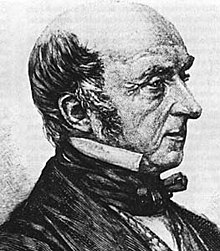Phillip Parker King

Admiral Phillip Parker King, FRS, RN (13 December 1791–26 February 1856) was an early explorer of the Australian coast.
King was born on Norfolk Island, to Philip Gidley King and Anna Josepha King née Coombe, and named for his father's mentor, Arthur Phillip, which explains the difference in spelling of his and his father's first names. Sent to England for education in 1796. King joined the Royal Naval Academy, Portsmouth, in 1802 and entered the Royal Navy in 1807 where he was promoted to lieutenant in 1814.
King was assigned to survey the parts of the Australian coast not already examined by Matthew Flinders, and made four voyages between December 1817 and April 1822. Amongst the 19-man crew were Allan Cunningham (botanist), John Septimus Roe and the aborigine Bungaree. The first three trips were in the 76 tonne cutter HMS Mermaid, but the vessel was grounded in 1820.
The Admiralty instructed King to discover whether there was any river 'likely to lead to an interior navigation into this great continent'. The Colonial Office had given instructions to collect information about topography, fauna, timber, minerals, climate, and the natives and the prospects of developing trade with them. From February 1818 until June the coast was surveyed as far as Van Diemen's Gulf and there were many meetings with Aboriginals and Malay proas. In June the Mermaid visited Timor and then returned to Sydney, arriving on 29 July. Next December and January King surveyed the recently discovered Macquarie Harbour in Van Diemen's Land and sailed in May 1819 for Torres Strait. King took John Oxley as far as the Hastings River, and continued on to survey the coast between Cape Wessel and Admiralty Gulf. King returned to Sydney on 12 January 1820.

King's fourth voyage was undertaken in the 154 tonne sloop HMS Bathurst. The ship headed north, through Torres Strait and to the north-west coast of the continent. Further survey of the west coast was made after a visit to Mauritius. Valuable contributions had been made to the exploration of Australia.
King had been promoted to commander in July 1821, and in April 1823 returned to England. He subsequently commanded the survey vessel HMS Adventure, and in company with HMS Beagle, spent five years surveying the complex coasts around the Strait of Magellan. The result was presented at a meeting of the Royal Geographical Society in 1831. King owned a property at Dunheved in the western suburbs of Sydney where he entertained Charles Darwin on Darwin's last night in Sydney in January 1836.
In February 1839, King was appointed to the New South Wales Legislative Council, and in April the same year was appointed resident commissioner of the Australian Agricultural Company, a position he held for ten years. In 1855 King was promoted to Rear admiral on the retired list. King was a Fellow of the Royal Society.
King was honored on the 2-pound postage stamp of Australia in 1963. The Australian native orchid Dendrobium kingianum has been named after him.
Works
- King, P. P. (1839), FitzRoy, Robert (ed.), Narrative of the surveying voyages of His Majesty's Ships Adventure and Beagle between the years 1826 and 1836, describing their examination of the southern shores of South America, and the Beagle's circumnavigation of the globe. Proceedings of the first expedition, 1826-30, under the command of Captain P. Parker King, R.N., F.R.S., vol. I, London: Henry Colburn.
- Sailing Directions to the Coasts of Eastern and Western Patagonia, and the Straits of Magellan and the Sea-Coast of Tierra del Fuego, 1832
See also
References
- The Oxford Companion to Ships and the Sea (Oxford, 1976) p. 450
- 'King, Phillip Parker (1791 - 1856)', Australian Dictionary of Biography, Volume 2, MUP, 1967, pp 61–64.
External links
- King's journals online
- NSW state papers holdings for Phillip Parker King
- NRA records for King
- Works by Phillip Parker King at Project Gutenberg
- Godley, E. J., Biographical Notes: Phillip Parker King (1791-1856)
- Phillip Parker King: The great hydrographer of the Magellanic sea. By Mateo Martinic (Spanish)
- Inauguration of Phillip Parker King's memorial in San Juan de la Posesión Bay (Chile)
- Monument to Captain Philip Parker King R.N.: San Juan de la Posesión Bay, Magellan Strait, (Chile)
- The Allan Cunningham Project Allan Cunningham was the botanist on HMS Mermaid and HMS Bathurst with Phillip Parker King
- The Tomb of Phillip Parker King an article from The Allan Cunningham Project
